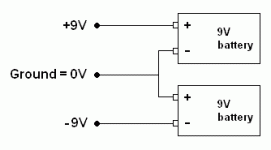What does it mean to "connect a potentiometer between a positive and negative voltage
I was looking at the spec sheet for an SSM2164 VCA and I saw that to produce gain, I need to connect the control voltage pot between positive and negative, as opposed to positive and ground. What does this mean?
I was looking at the spec sheet for an SSM2164 VCA and I saw that to produce gain, I need to connect the control voltage pot between positive and negative, as opposed to positive and ground. What does this mean?
The way I read it, you only need to connect the control voltage pot between positive and negative when you want both gain AND attenuation.
In other words, if you just reference between positive and ground, the VCA will go from unity gain (when the pot's wiper is at ground), to some positive gain. Going between positive and negative lets you go from some positive gain, to unity gain, to some negative attenuation.
se
In other words, if you just reference between positive and ground, the VCA will go from unity gain (when the pot's wiper is at ground), to some positive gain. Going between positive and negative lets you go from some positive gain, to unity gain, to some negative attenuation.
se
so would I get the full 20 dB of gain when the wiper is connected to the positive side or the negative side?
so would I get the full 20 dB of gain when the wiper is connected to the positive side or the negative side?
My bad. I read the datasheet a little too hastily.
When the pot is connected between positive and ground, you only get unity gain and attenuation with unity gain being when the control voltage is 0 volts.
So if you want gain, you'll need to connect the pot between a positive and negative voltage (relative to ground). So in that case, you'll get gain as the control voltage goes negative.
To be honest, I don't know just how the amount of gain is established. I know the datasheet says it has a maximum of 20dB, but I'm not sure if that's only the case when the negative control voltage is equal to the negative supply rail voltage.
Perhaps someone else can chime in on that issue.
se
so I would essentially be connecting the fader in a way where as I pull the fader down/toward me, I increase the voltage?
so I would essentially be connecting the fader in a way where as I pull the fader down/toward me, I increase the voltage?
Depends what it is you're wanting the fader to do when you pull it down/toward you.
Do you want it to be attenuating? Or do you want gain as well?
se
well, I would like the fader to operate exactly like the Yamaha PM4000 I've fallen in love with: negative infinity attenuation all the way down, unity gain 80% of the way up, and then +10 dB gain (before assignment to the VCA groups) at the very top of the fader's travel
the faders I'm looking at using are 100mm (and 60mm for the tape return channel) Panasonic audio potentiometers at 10K of resistance throughout the mixer, except for the matrix send masters, where I will use a log 10K pot as the fader.
well, I would like the fader to operate exactly like the Yamaha PM4000 I've fallen in love with: negative infinity attenuation all the way down, unity gain 80% of the way up, and then +10 dB gain (before assignment to the VCA groups) at the very top of the fader's travel
Ok, if you want both gain and attenuation, you need to connect the pot between a positive and negative voltage.
se
with resistors in series at both ends to limit the range.... you need to connect the pot between a positive and negative voltage.
with resistors in series at both ends to limit the range.
resistors?
- Status
- Not open for further replies.
- Home
- Design & Build
- Construction Tips
- What does it mean to "connect a potentiometer between a positive and negative voltage
